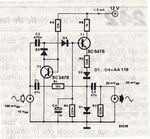neazoi
Advanced Member level 6
Hi, I need a discrete components circuit for an audio compressor, or automatic audio level control, or audio limiter, or whatever it is called, for my receiver presented at the end of this page **broken link removed**
I want to bring the low level audio signals and the high level audio signals at the same audio level.
I am trying not to attenuate the audio output of it much, so the circuit must have close to unity gain.
I have tried the attached circuit bit it did not have any effect in my receiver, it only attenuated the audio quite a lot.
I have also tried a set of antiparallel germanium diodes before the volume pot.
I think that a good option would be to use an LDR as a variable attenuator or for varying the 2.2M feedback resistor of the final audio amplifier. However these contain cadmium which I do not like much, but if it can't be done other wise better...
Any ideas to try?
- - - Updated - - -
Searching around I found this **broken link removed** maybe this is good and can handle low levels I do not know.
Any ideas?
I want to bring the low level audio signals and the high level audio signals at the same audio level.
I am trying not to attenuate the audio output of it much, so the circuit must have close to unity gain.
I have tried the attached circuit bit it did not have any effect in my receiver, it only attenuated the audio quite a lot.
I have also tried a set of antiparallel germanium diodes before the volume pot.
I think that a good option would be to use an LDR as a variable attenuator or for varying the 2.2M feedback resistor of the final audio amplifier. However these contain cadmium which I do not like much, but if it can't be done other wise better...
Any ideas to try?
- - - Updated - - -
Searching around I found this **broken link removed** maybe this is good and can handle low levels I do not know.
Any ideas?
Attachments
Last edited:



